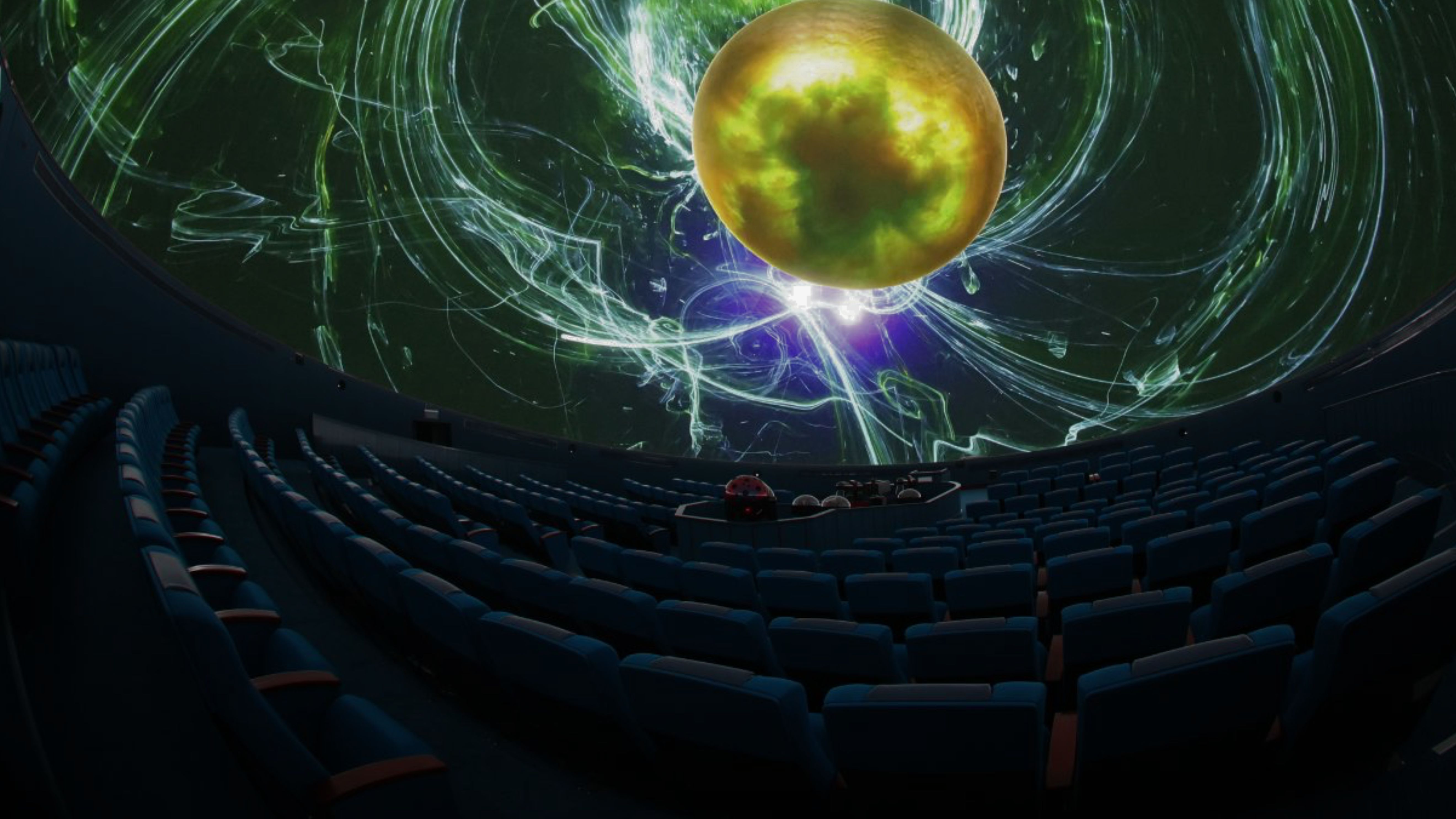
Since 2004, 7thSense has been at the heart of the planetarium and dome theatre world, powering experiences that transport audiences beyond the confines of the screen.
From early digital fulldome conversions to today’s large-scale immersive environments, 7thSense media servers and pixel processing systems have been chosen by some of the most respected and forward-thinking institutions including Morrison Planetarium at California Academy of Sciences (San Francisco), American Museum of Natural History (New York), Shanghai Planetarium (Shanghai Astronomy Museum), Cosmonova (Swedish Museum of Natural History), Adler Planetarium (Chicago), Sphere Las Vegas, Mayborn Planetarium (Killeen, TX), Winchester Science Centre (UK), Our Dynamic Earth (Edinburgh), the National Space Centre (UK), Taipei Astronomical Museum (TAM), and Children’s City (Dubai), among many, many others.
Why domes are different…
A dome is a uniquely demanding type of display. The audience sits inside the image, surrounded by the picture. Every detail of brightness, geometry, and motion is visible from every seat. Any artefact, whether it be a slight misalignment, flicker, or visible frame edge, breaks the immersive illusion immediately. This is why the underlying playback and processing technology is so critical.
Three core elements define reliable and high-quality fulldome delivery:
1) Blending and warping you can trust
Multi-projector domes require precise geometric mapping and edge-blending that maintain accuracy and consistency under close inspection. From complex star fields to fast motion graphics, the system must deliver clean joins, stable black levels, and seamless transitions between projected images. Automated alignment tools and calibration workflows help ensure the dome remains perfectly uniform, even after hours of daily operation.
2) Genlock and deterministic sync
In dome theatres, synchronisation is essential. Genlocked playback across multiple servers, projectors, LED processors, and external sources ensures that every frame lands together, eliminating tearing or jitter. Whether running at 24, 30, 60, or 120 frames per second, deterministic timing keeps visual content, audio, and interactive elements perfectly aligned. Stable genlock and timecode integration ensure the entire system behaves as one.
3) Uncompressed or visually lossless playback.
By virtue of their size relative to the viewer, domes reveal every flaw in an image. Compression artefacts, colour banding, and noise are easily visible, especially in gradients, star fields, and high-contrast scientific content. This is why fulldome and planetarium operators have long preferred uncompressed or high-bitrate visually lossless formats that preserve every detail and maintain dynamic range. High-quality playback ensures images remain sharp, colours consistent, and blacks deep.
The original media server for domes
From the beginning, 7thSense set out to be the agnostic backbone of immersive visual storytelling. Our media servers were trusted to connect creative intent with any display technology. That approach has made 7thSense a long-term partner to some of the most innovative dome venues around the world.
Being display-agnostic means more than supporting multiple outputs. It means working seamlessly with any projection brand, lens configuration, LED processor, or show control platform. While always maintaining frame-accurate playback, consistent latency, and dependable performance.
Pixel processing that preserves quality
In a dome, every pixel counts. A good pixel processor does more than distribute video signals; it preserves image integrity from source to display surface. That includes precise geometric correction, smooth blending, and colour uniformity across the entire canvas. 7thSense pixel processing delivers:
High-accuracy warp and blend at the final raster, with options for crosstalk prevention and black level compensation.
Per-channel colour calibration and luminance correction for visual uniformity.
Genlocked output and deterministic frame delivery, so edges remain stable and motion remains smooth.
Redundancy and failover protection to ensure reliability in continuous daily operation.
Supporting both real-time and pre-rendered content
Modern dome theatres combine cinematic pre-rendered content with real-time visualisation and interactive storytelling. 7thSense systems are designed to handle it all, playing uncompressed image sequences, hosting real-time engines, and integrating with lighting, audio, and show control systems through open APIs. This flexibility allows venues to mix education, live presentation or performance, and data visualisation within a single ecosystem.
The future: LED domes and next-generation projection
The future of dome theatres is being shaped by two major display technologies.
LED domes
Fine-pitch LED has begun to appear as a new format for immersive environments, offering exceptional brightness, contrast, and black levels that were once impossible to achieve with projection. Building an LED dome introduces new challenges such as curved surface geometry, segment joins, scan pattern management, and maintaining genlock across multiple LED controllers. These demands push playback systems to handle higher bandwidths and more precise synchronisation than ever before. A display-agnostic server is essential to bring it all together.
Next-generation projection
At the same time, projection technology continues to evolve. RGB laser projectors with higher brightness, extended colour gamuts, and improved black levels are redefining what is possible for traditional domes. Auto-alignment systems, dynamic calibration, and HDR pipelines are improving consistency and contrast, ensuring projection remains a powerful and cost-effective option for both new and existing theatres.
In both LED and projection systems, timing and precision remain fundamental. Deterministic genlock, frame-accurate playback, and calibrated blending are still the cornerstones of a believable dome experience.
What this means for operators and creators
For operators, the focus is on reliability, maintainability, and flexibility. Systems must be easy to align, simple to update media, and built for round-the-clock operation. Automated calibration, remote monitoring, and fault-tolerant architecture are critical for venues that host multiple shows each day.
For creators, the emphasis is on quality and creative freedom. Uncompressed playback preserves subtle image details, stable synchronisation ensures smooth motion, and open pipelines allow artists and producers to work across multiple formats without compromise.
For more than twenty years, 7thSense has been the trusted, display-agnostic backbone behind many of the world’s leading domes and planetariums. As technology evolves, the goal remains the same: to make the tools invisible, so audiences can lose themselves in the wonder of the universe.